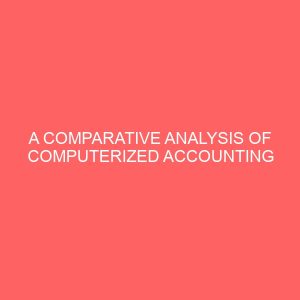ANALYSIS AND INTERPRETATION OF FINANCIAL STATEMENT AS A MANAGERIAL TOOL FOR DECISION MAKING (A CASE STUDY OF NWOKEJI URBAN PLANNING AND ARCHITECTURAL STUDIO [NUPAS]
Abstract
Financial Statement Analysis and Interpretation is a very vital instrument of good management decisionmaking in business enterprise. Good decisions ensure business survival, profitability and growth. Without financial statement analysis in investment decisions, an enterprise is likely to make decisions, which could spell its doom. Poor or lack of qualitative financial statement analysis could lead to investment returns, low profitability and even inability to identify viable investment opportunities. The main objective of this project is therefore, was to determine how firms could use financial statement analysis and interpretation to aid management decisions and to avert the problems highlighted above. Primary and secondary data are employed to broaden the scope of this study. Primary data are sourced from questionnaire responses. This provided data for the validation of the hypotheses tested with the use of chisquare X2. The test revealed as follows: 1 Significant difference between the returns of the financial statement in Analysis and Interpretation based on management decision. 2 Organizational profitability has relationship with financial statement analysis and interpretation based management decision but not significantly. The project concludes that companies should pay great attention to the use of financial statement analysis so as to properly equip themselves with this invaluable tool. The researcher recommends the following: a Accountants or financial analysts should not be rushed in collection, preparation, analysis and interpretation off financial statements. b Financial statements should be made to reflect current cost accounting to eliminate or reduce the effects to historical cost principle and inflation risk element. c A combination of different ratios should be used in analyzing a companys financial and/or operating performance. Proper use of financial statement analysis should be made not only in investment but also in other areas of decision making.
CHAPTER ONE
1.0 INTRODUCTION
1.1 Background of the Study
The complex nature of todays business world and the transformation of the entire world into a global village have been of great concerns to manages of all forms of business organizations. According to Ojuigo 2001, the problems of managers are multi:varied because of inefficiency in management of poor decision outcomes of these organizations. Therefore, the managers are unable to achieve the organizational objective within a period of time.
As diverse as business is, its controllable and uncontrollable factors influence all decisions which ultimately lead to the realization of set objectives. To achieve this, management needs reliable, authentic and relevant information from the financial statements to efficiently facilitate decision making.
It must be noted that every business stores at making at least from investments sustainable profits so as to stay afloat and continue in business. Therefore, profit being the concern of every manager is a factor in business. To achieve this, available information from the financial statements of organizations must be analysed, interpreted and used as a basis for decision making Needham and Dransfield 1991. Financial statement analysis is often considered as a vital tool used in evaluating a companysperformance and ensuring that decisions are based on facts rather than rule of thumb.
A financial analyst needs financial statements of companies to be able to identify operating and financial problems which may affect the companies Mbat, 2001:60. Thus, any person who analyses the financial statements of firms should be able to identify the cause and effect of financial and operating problems of such firms.
The cause of any financial or operating problem is an event, which produces an effect the problem. However, in order to identify the cause and effect, the system, which represents an indictor f the problem, should be observed. This process is referred to as interpretation Pandey, 2005. According to Mbat, 2001, it is the responsibility of the financial manager or analyst to enable them make better management decisions.
The symptoms could be:
Declining liquidity
Declining profit
External debt recovery period
Increased volume of inventory
Declining return on total assets
Increasing operating expenses etc
The identification of causes should also be important in order to appropriately evolve corrective measures.
Financial analysis and interpretation assist in the:
Identification of organizational performance through the use of analystical data.
Identification of empirical relationships between operating results and those items which have influenced the achievement of the results.
Identification of historical data order to determine which internal or external factors have exerted positive or negative influence on the operating results Mbat 2001:61.
Categorically, there are three forms of financial analysis. These include: multivariate, univariate and ratio analysis Welsh, 1987. Moreover, ratios are the end results of basis analysis. The ratio requires an interpretation on the basis of their trends and in the lights of what is known of the business as a young concern. It should be noted that financial statements represent the positions of a firm at a particular point in time.
However, the success or failure of a business depends largely on the quality of decisions made by management, which in turn depends on reality of accounting information available on them.
1.2 Statement of the Problem
The principal aim of making investment decision is to get adequate returns from it. According to Needham and Dransfield 1991, people as a rule will only tie up their money in a business if they are satisfied with the returns they get from it.
In an attempt to achieve maximum returns from investment in production, services shares or stock and/or other securities outside the firm, a comprehensive analysis of the company which is intended to be invested in should be carried out using the companys financial statements to ascertain both its explicit and implicit investment opportunities. However, organizations that do not use financial statement analysis in making investment decisions could be ill formed. As a result, the following problems may arise:
i Inability to identify viable investment opportunities
ii Decreasing returns from investments.
iii Decline in organizational overall profitability.
iv Increased investment risk: The organization might not achieve its corporate objective at the end of the period.
If the trend continues, it will likely lead to the failure of the organization. Therefore, there is a great need for organizations to consider and analyse companys financial statements before investing in that company. These are the focus of this study.
Original price was: ₦3,200.00.₦3,000.00Current price is: ₦3,000.00.





![ANALYSIS AND INTERPRETATION OF FINANCIAL STATEMENT AS A MANAGERIAL TOOL FOR DECISION MAKING (A CASE STUDY OF NWOKEJI URBAN PLANNING AND ARCHITECTURAL STUDIO [NUPAS]](https://projectslib.com/storage/2022/12/analysis-and-interpretation-of-financial-statement-as-a-managerial-tool-for-decision-making-a-case-study-of-nwokeji-urban-planning-and-architectural-studio-nupas_26376.jpg)


Reviews
There are no reviews yet.